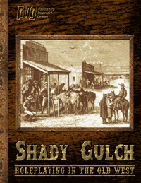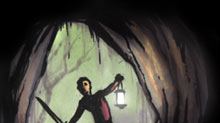by Demian Katz
 Shady Gulch: Roleplaying in the Old West
Shady Gulch: Roleplaying in the Old West
Written and designed by Brett M. Bernstein
Published by Politically Incorrect Games
49 page PDF
$5
I received Shady Gulch along with review copies of the first two of Politically Incorrect Gamesí genreDiversions products. I didnít have very high hopes for it since, on a quick glance-through, it seemed to consist almost entirely of system rules, and Iíve never been a tremendous fan of the Wild West genre to begin with. Indeed, I wasnít astounded by the game, though it turned out to be a more solid product than I had anticipated.
Mosey Into Town
After a toner-guzzling cover and some credits, the book starts off with five pages of background material including the requisite explanation of role-playing, an introduction to the Old West, some slang terms, a list of common locations in a Western town, notes on foreigners and natives, and a timeline of major events. Much of this information is useful and interesting, and it serves to set the tone for the game, but itís a rather haphazard collection of stuff. The detail level is high on what information is presented, but you can only do so much in five pages, so the whole introductory section feels rather like an excerpt from a larger work.
The next thirty pages describe character creation, combat and other core rules. As I said, rules make up the bulk of this product. The basic game system is basically a slightly bulkier version of the rules found in the later genreDiversion products. Most actions are resolved by rolling two six-sided dice and comparing the result to a target number created by adding a trait value and a skill value. Tasks can be made easier by adding bonus dice (roll extra dice, then add the highest two numbers rolled) or made harder by adding penalty dice (roll extra dice, then add the lowest two numbers rolled). A table is provided for determining the degree of success achieved under different levels of difficulty. Opposed rolls are resolved by comparing these degrees of success and awarding victory to the more successful player. As I keep saying in reviews of games from this product line, the system isnít anything new and exciting, but it gets the job done easily and efficiently.
As my description of the core game mechanic implied, characters in Shady Gulch consist mostly of traits (Strength, Dexterity, Perception, Reasoning and Willpower) and skills (which are associated with the traits). For extra flavor and role-playing, there are also virtues and vices to choose from. Character creation is totally point-based, but players are required to choose a Vocation (Cowboy, Gambler, Homesteader, Tradesman, Lawman, Outlaw, Scholar, Soldier, Businessman or Drifter) which determines which skills can be purchased at discounted point costs and which virtues and vices are required, recommended or allowed. The system is a little bit restrictive, but itís also fast; in any case, a little GM flexibility should overcome the worst of its limitations.
Combat is straightforward, with different weapons requiring different applications of the basic game mechanic. The remainder of the rules cover such things as reputation, coping with injury, tracking intoxication (which is given a greater emphasis than in most games - thereís even a spot for it on the character sheet), dealing with horses, and even writing books. Like the introductory material, the bookís special rules convey an appropriate Wild West flavor but donít feel comprehensive. Some things are more detailed than others, and it seems like more could have been added; still, what is here is enough to give the GM a good idea of how to apply the system to different ideas.
Following the rules, the book contains six pages of GM material. Thereís some useful (but not necessarily original) advice, a note on keeping track of time (which is done very loosely in this game), and then a long list of story ideas, some potential subplots for characters to get involved in, and a handful of ready-to-use NPCs. Although I was initially disappointed that the game didnít include any full-fledged sample adventures, I actually think that its ďlist of ideasĒ approach was preferable. Sample adventures often tend to be space-wasters resulting from a simplistic core plot being half-heartedly expanded upon. It makes a lot more sense to include a couple dozen simplistic core plots ready to be fleshed out by the GM than to waste space and time fleshing out just one such idea into something useless. The author has created a really handy little toolkit for creating adventures here, and while no single idea is particularly original, the variety presented gives a good idea of what all can happen during a Western campaign.
The book concludes with a few more handy tools: miniature character sheets for the pregenerated characters, a summary of all useful tables, a blank full-sized character sheet, and a brief index. Itís a nice final touch to a modest but successful product.
Conclusions
Being rather inexperienced with the world of Western RPG products, I canít offer a definitive impression of how this fits into the grand scheme of things. Still, I think it may actually have found a comfortable niche despite a lot of strong competitors. Itís likely more realistic and campaign-oriented than Deep7ís Western 1PG, Six Gun, and itís more reality-based than Pinnacleís popular Deadlands (the playerís guide for which, I should note, is now available for free from RPGNow, the same site that sells this game). It may well make a good complement to some of Knuckleduster Publicationsí generic Western RPG accessories. Itís probably not ideal for players like myself without much Western experience, but if you enjoy the genre, feel like creating your own adventures and just need a straightforward, solid system, this should serve you well.




